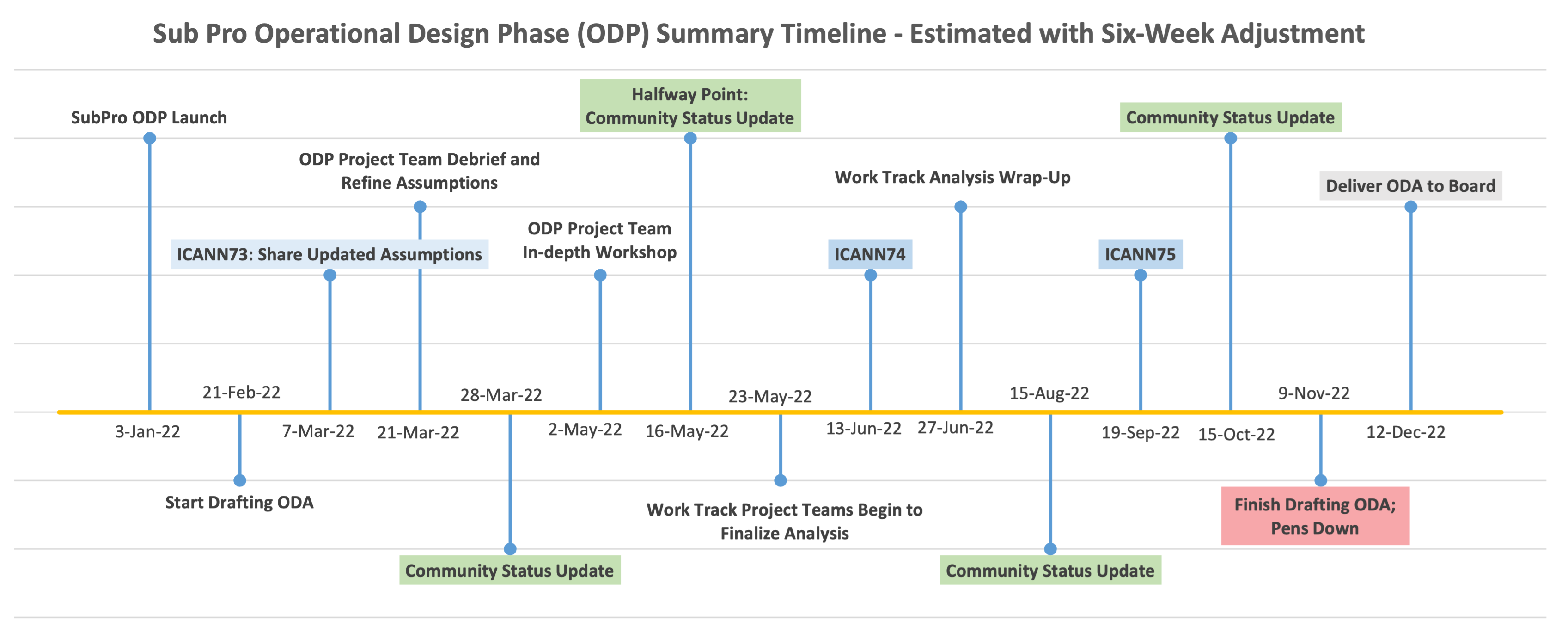New gTLD Subsequent Procedures Operational Design Phase
Announcements, Blogs, Webinars, and More
To read and learn more about the New gTLD Subsequent Procedures ODP, please see the information ICANN org has published here.
About the New gTLD Subsequent Procedures Operational Design Phase
On 18 February 2021, the Generic Name Support Organization (GNSO) Council voted to approve the New Generic Top Level Domain (gTLD) Subsequent Procedures Policy Development Process Final Report (the "Final Report"). The Final Report contains Affirmations, Recommendations, and Implementation Guidance (collectively referred to as "Outputs"). On 24 March 2021, following the approval of the Final Recommendations, the GNSO Council transmitted its Recommendations Report to the ICANN Board.
The Final Report Outputs concern complex operational requirements, and the Board will benefit from further due diligence to evaluate the impact of implementing the Final Report Outputs. Therefore, on 12 September 2021 the ICANN Board directed the ICANN President and CEO to organize the resources required to begin work on the ODP, and to advise the Board when the work of the ODP is initiated within the organization.
The ODP's purpose is to facilitate the Board's determination whether the Outputs contained in the Final Report are in the best interest of the ICANN community or ICANN, in accordance with the ICANN Bylaws1.
As per the Subsequent Procedures Scoping Document, the ODP, conducted by ICANN org, will assess the potential risks, anticipated costs, resource requirements, timelines, dependencies, interaction with the Global Public Interest Framework that is currently being piloted, and other matters related to implementation of the Outputs included in the Final Report. In doing so, the ODP will produce an Operational Design Assessment (ODA) that will be delivered to the Board for its consideration alongside the Final Report Outputs, public comment on the Final Report Outputs, and any other relevant materials.
The Board has requested the ODA be delivered within ten months from the date of initiation, provided that there are no unforeseen matters that could affect the timeline.
The ODP is a transparent process and ICANN community engagement plays an important role. To follow ICANN org's work on the ODP for New gTLD Subsequent Procedures, please see the Work Products section of this webpage. To enquire about opportunities for community feedback please see the Engage section of this webpage.
To review ICANN's Operational Design Phase Process Paper, or to learn more about the overall process, click here.
This high-level timeline of the New gTLD Subsequent Procedures Operational Design Phase indicates key milestones including internal ICANN team deliverables, community status updates, and upcoming ICANN public meetings.
Work Products
All work products, including the Operational Design Assessment, once submitted to the Board, will be published in this section.
- New gTLD Subsequent Procedures-ODP | New gTLD Subsequent Procedures Operational Design Assessment (ODA)
- New gTLD Subsequent Procedures-ODP | Scoping Document
- New gTLD Subsequent Procedures-ODP Request | Board Resolution
-
Community Status Updates:
- Community Status Update – 16 May 2022
- Community Status Update – 28 March 2022
- Community Status Update – 15 August 2022
- Community Status Update – 14 October 2022
-
Assumptions:
- Initial Assumptions Subsequent Procedures ODP v.1 [Shared on 28.02.2022]
- Initial & Overarching Assumptions Subsequent Procedures ODP v.2 [Shared on 23.03.2022]
- Assumptions Subsequent Procedures ODP v.3 [shared 29 April 2022]
- Assumptions Subsequent Procedures ODP v.4 [shared 25 May 2022]
- Assumptions Subsequent Procedures ODP v.5 [shared 15 August 2022]
- Assumptions Subsequent Procedures ODP v.6 [shared 8 November 2022]
- Assumptions Subsequent Procedures ODP v.7 [shared 9 December 2022]
Engage
The New gTLD Subsequent Procedures-ODP is an open and transparent process. All stakeholders are encouraged to share their feedback. Methods for sharing are provided here.
- Community Feedback - Feedback on the New gTLD Subsequent Procedures-ODP can be submitted at any time by using the below button. All community input will be captured transparently here.
- To contact the ICANN org regarding this project please email: subpro-odp@icann.org
- To submit your feedback
- To view previously submitted feedback
1 ICANN Bylaws, Annex A, Section 9 (a), Any PDP Recommendations approved by a GNSO Supermajority Vote shall be adopted by the Board unless, by a vote of more than two-thirds (2/3) of the Board, the Board determines that such policy is not in the best interests of the ICANN community or ICANN.

